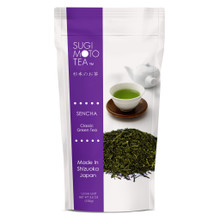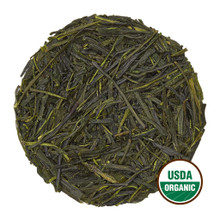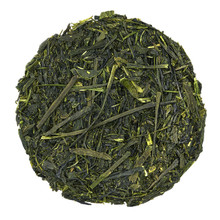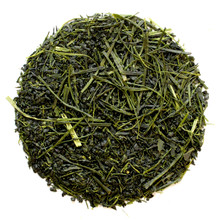Sencha: A Celebration of Japan’s Most Beloved Tea
While matcha continues to shine on the global stage, sencha quietly remains at the heart of daily life in Japan. Often overlooked in international tea conversations, sencha is the most widely consumed green tea in the country. It is deeply rooted in tradition, simplicity, and a sense of connection.
With recent matcha shortages, we've had more opportunities to reflect on the beauty of loose leaf teas. Among them, sencha stands out as something truly special. It is not a substitute for what’s missing but a celebration of what has always been present.
At its best, sencha offers a richly layered experience. Its flavor shifts with the season, the growing region, and the care of the people who craft it. Now is the perfect time to reconnect with sencha and discover everything it has to offer.
What Is Sencha?
Sencha is a type of Japanese green tea made from whole tea leaves that are steamed, rolled, and dried before brewing. Unlike matcha, which is ground into a fine powder and whisked, sencha is prepared by steeping the leaves in hot water. It is the most common style of green tea in Japan and offers a wide range of flavor profiles depending on how it is grown and processed.
The taste of sencha can vary greatly based on several factors. One key difference is the steaming level. Lightly steamed sencha, known as asamushi, tends to have a clear, delicate flavor, while deeply steamed fukamushi sencha produces a bolder, fuller-bodied brew with a slightly cloudy appearance. The region where the tea is grown also plays a role, with climate and soil influencing aroma and taste. Even the cultivar, or variety of tea plant, contributes to the final flavor, making sencha a fascinating tea to explore.
For many, sencha serves as an ideal introduction to Japanese green tea. It reflects the care and craftsmanship of traditional tea production and opens the door to exploring the depth and variety found across Japan’s tea traditions.
History of Sencha
What we know today as sencha emerged during the Edo period as a response to the formality of the tea ceremony. Inspired by Chinese steeped tea culture, Japanese intellectuals and townspeople began seeking a simpler, more contemplative way to enjoy tea — one that could be steeped and savored in everyday life. In 1738, Nagatani Sōen of Uji-Tawara pioneered a new method of tea processing that involved steaming, rolling, and drying the leaves to preserve their vivid color and fresh, grassy aroma. The tea he produced quickly spread through the country, becoming what we now know as “sencha”.
By the mid-19th century, sencha played a pivotal role in opening Japan to international trade. When Commodore Perry arrived in 1853, followed by the opening of Japanese ports through the Ansei Treaties in 1858, tea, alongside silk, became one of Japan’s most important exports. Entrepreneurs helped send massive shipments of Japanese tea, especially sencha, to the United States and Europe. Foreign merchants set up tea-processing hubs in Yokohama, where Japanese tea was refined, sorted, and roasted for export. By the Meiji era, sencha was overtaking other green teas like kamairicha (pan-fired green tea) in both domestic and export markets.
Mechanization soon followed with innovations in tea processing, from steaming equipment to rolling machines, which helped scale production to meet rising global demand. Yet as exports boomed, quality control issues eventually emerged. By the early 20th century, the U.S. began turning to more consistent black teas from India, and Japan’s tea exports began a long decline. After World War II, domestic tastes shifted again. While black tea briefly gained popularity, sencha returned to prominence as a symbol of national identity in postwar Japan.
Today, sencha is by far the most widely consumed tea in Japan, found in homes, offices, and vending machines alike. For most people, “green tea” simply means sencha. While its origins lie in a blend of Chinese influence, domestic innovation, and global trade, sencha has come to represent something uniquely Japanese. It is no longer just a drink, but a quiet fixture of daily life. Its widespread presence speaks not only to its flavor and versatility, but to the enduring appeal of a tea that evolved alongside modern Japan itself.
Sencha and the Sugimoto Legacy
Sencha has always been at the heart of our work. It was the very first tea we produced at Sugimoto Tea Company, and it continues to reflect the values that have guided our family for generations: craftsmanship, hospitality, and a deep care for both people and the land.
From the beginning, our goal was simple. We wanted to share high-quality Japanese tea that could be enjoyed with ease and sincerity. Sencha was the perfect starting point. Its approachable nature and rich character made it an ideal expression of what we stood for.
As Kyohei Sugimoto, third-generation of Sugimoto Tea and president of our US operations, often says, "Sencha is the tea that connects us to everyday life. It reminds me of the mornings I spent with my grandfather, watching him brew it with quiet focus and pride. That memory is why I continue this work today."
Today, sencha remains our signature tea. It reflects our roots, supports our present, and continues to inspire our future.
The Future of Sencha: A Tea Worth Preserving
Today, sencha faces an uncertain future. Many tea farmers in Japan are aging, and younger generations are often moving away from tea cultivation. At the same time, domestic demand for loose leaf tea continues to decline. With the rise of convenience-driven lifestyles, fewer people in Japan are brewing sencha at home the way they once did.
Despite these challenges, we believe sencha still has a meaningful place in the world. Our mission is to help share its value with a global audience, not only as a delicious and grounding tea but as a living tradition worth preserving. By supporting farmers who continue to grow and process high-quality sencha, we’re working together to keep this craft alive.
Every time you enjoy a cup of sencha, you help sustain a centuries-old tradition and support the real people and families who dedicate their lives to producing it with care and integrity.
How to Brew and Enjoy Sencha
Brewing sencha is a simple yet thoughtful process that brings out the tea’s delicate character. A typical cup starts with about 5 grams (2 tsp) of tea leaves to 12 ounces (350 ml) of water. The water should be around 160°F to 175°F (70°C to 80°C) to avoid bitterness. Steep the leaves gently for 30 seconds to 1 minute, depending on your preferred strength.
In warmer months, sencha also makes an excellent cold brew. Add 5 grams (2 tsp) of sencha to 12 ounces of cold water, let it steep in the fridge for about 10 to 15 minutes. This method draws out the tea’s natural sweetness while keeping bitterness to a minimum.
Another refreshing option is iced brew, or kooridashi, a traditional Japanese method that uses ice instead of water. Simply place sencha leaves over ice and allow them to melt slowly. As the ice dissolves, it releases the tea’s flavor drop by drop, resulting in an incredibly smooth and concentrated brew. This method is especially well suited to high-quality sencha and creates a rich and silky cup with deep umami and almost no bitterness.
You can also get creative with flavor by adding herbs to your cold brew. One of our favorite combinations is Rosemary Sencha:
Rosemary Sencha Cold Brew
Ingredients:
- 2 tablespoons Sencha Fukamushi
- 2 stems of fresh rosemary
- Optional: Sparkling water
Instructions:
- Add the tea leaves and rosemary to your cold brew bottle.
- Fill with cold water and let steep in the refrigerator for 20 to 30 minutes.
- Strain and enjoy as is, or top with sparkling water for a refreshing twist.
Tip: You can also experiment with other herbs like lavender or basil, which pair beautifully with sencha.
Beyond taste, preparing sencha is a moment of pause. Measuring the leaves, watching them unfurl, and steeping with intention can bring a sense of calm and clarity. This quiet mindfulness is at the heart of Senchado, a Japanese tea tradition that focuses on enjoying loose leaf teas like sencha and gyokuro. Rooted in simplicity and conversation, Senchado invites people to slow down and appreciate the beauty of everyday tea.
Whether served hot, cold, or over ice, sencha invites us to reconnect with ourselves, our surroundings, and the centuries of care that continue to shape each cup.
Discover Our Signature Senchas
Each sencha has its own unique story, shaped by the region, cultivar, and steaming process. Whether you’re just beginning your tea journey or looking to explore new dimensions of flavor, we offer a variety of senchas to suit every taste.
Our signature sencha and best-seller, Enrich Sencha Fukamushi is a deep-steamed (fukamushi) tea from Shizuoka, finished with a high-temperature roasting — a technique passed down in the Sugimoto family. This roast enhances the tea’s rich aroma and creates a smooth, umami-forward cup with a lasting finish. Its balanced character makes it an excellent daily tea, and its flavor holds up beautifully through multiple steeps.
Hot brew: 5g tea / 12 oz water / 175°F / 30–60 sec
Cold brew: 5g tea / 12 oz ice water / 10 min
Light, clean, and crisp, this lightly steamed sencha is made from certified organic spring and early summer leaves. The asamushi style results in a clear, pale green cup with a refreshing finish and a gentle sweetness. It’s especially well suited to anyone seeking a softer, more delicate profile.
Hot brew: 5g tea / 12 oz water / 175°F / 1–2 min
Cold brew: 5g tea / 12 oz ice water / 10–15 min
Medium-steamed and slightly more traditional in appearance, our Sencha Chumushi strikes a balance between the clarity of asamushi and the boldness of fukamushi. The leaves remain more intact, resulting in a vibrant green liquor with a bright, vegetal flavor and subtle astringency. This tea is a great choice for those who appreciate a more classic sencha profile.
Hot brew: 5g tea / 12 oz water / 175°F / 30–90 sec
Cold brew: 5g tea / 12 oz ice water / 10–15 min
Single-Cultivar Sencha Saki Midori
Grown in Izumi, Kagoshima, Saki Midori is a rare single-cultivar sencha available in limited quantities. Shaded before harvest and deep-steamed in the fukamushi style, this tea offers a vibrant green liquor with a grassy, seaweed-rich aroma and subtle floral notes. Its high amino acid content creates a smooth, umami-rich body with a gentle astringency and a red wine-like finish. A beautiful choice for connoisseurs or anyone looking to explore the layered complexity of Japanese sencha.
Hot brew: 5g tea / 6 oz water / 175°F / 60 sec
Cold brew: 5g tea / 10 oz ice water / 10–15 min
Closing Thoughts
This season, take a quiet moment to brew a pot of sencha. Let the warmth, aroma, and rhythm of preparation bring a sense of calm.
Loose leaf tea has long been part of daily life in Japan, shaped by generations of care and intention. When you drink sencha, you’re taking part in something that continues to connect people, place, and tradition in a quietly meaningful way.
We hope this inspires you to enjoy sencha in your own way — simple, thoughtful, and rooted in the present.



